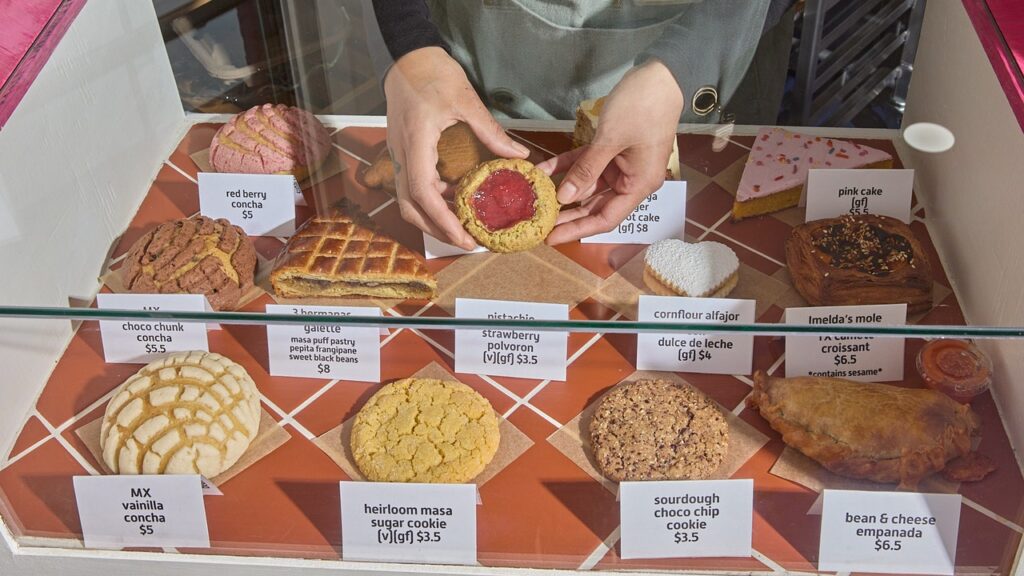If last year’s restaurant culture was defined by endlessly creative martinis and heated debates over tipping, then in 2024 it was all about sourdough conchas and bars with seriously good food. We cooled it on the booze, took up tea, and lined up for pastries at genre-defying bakeries.
Some of the most fun we’ve had in a year full of smash burgers and Caesar salads involved menus shaped by culinary crossovers: Restaurant takeovers and guest dinners are the moment’s favorite way to party—for restaurant staff and diners alike.
In a movement that’s been building for years, many of this year’s most exciting chefs and bakers make food unique to their identities and backgrounds. In the US and abroad, women are now running some of the most esteemed restaurants in the world, reshaping the dining landscape from New York to Saõ Paolo to Paris.
These eight trends shaped restaurant culture in 2024.
The Golden Era of Chef Crossovers is Here
A spirit of collaboration was the underlying theme defining this year’s best new restaurants. As restaurant editor Elazar Sontag wrote in September, “Chefs across the country are wholeheartedly embracing collaboration, pulling ideas from cooks and waiters, their mentors, and other restaurants to create unique menus infused with personality and a real sense of place.”
Read More
The 20 Best New Restaurants of 2024
From breakout barbecue in Lockhart, Texas, to Vietnamese drinking food with a Miami spin, these are the best new restaurants in the US.

The spirit of pandemic-era pop-ups is evolving, and restaurant takeovers have become a favorite mode of culinary expression for chefs nationwide. Now even chefs with brick-and-mortar restaurants are popping up at other restaurants—to stay fresh and leverage each others’ networks. On any given night it’s become common to find a chef from one corner of the country (or globe) taking over the kitchen of another. Chefs are paying attention to the work of their colleagues, taking note of other restaurants that embody their cooking styles or culinary philosophy. This results in all-too-fleeting dinners capturing a sense of combined creativity.
San Francisco’s Zuni Café at Quo Vadis in London. New York’s HAGS at Oyster Oyster in DC. Birdie’s of Austin at New York’s Gramercy Tavern. The famed Bistrot Paul Bert of Paris popping up at Leo in Brooklyn. There was a time when destination dining required much more travel. Now, as talented chefs rove freely, the most difficult part is booking your spot. (Follow your favorite restaurants on Instagram and check in often, as these meals tend to sell out as quickly as word spreads.)
We’re Drinking Less…
“Nobody’s drinking anymore.” That’s how one Los Angeles restaurateur put it to me bluntly over coffee the other week. While that’s an exaggeration, it’s been reported many times over that the youth aren’t drinking like past generations—data published by the International Wine and Spirits Record in May found that 54% of Gen Z consumers of legal drinking age have abstained from alcohol in the past six months. As a result, wine and liquor sales are down at restaurants, and restaurateurs are feeling it. Historically, mark-ups on alcohol have been a surefire way to generate profit, but that’s changing. The silver lining is that the NA drinks boom is only getting louder, and diners are willing to spend on carefully crafted no-booze beverages.
Many of the bars that made Bon Appétit’s list of the Best New Bars of 2024 place a high value on booze-free cocktails. New York’s Superbueno serves an NA mole Negroni for $18.50, while the menu at Wildchild in Shawnee, Kansas, features a remarkable list of 14 non-alcoholic drinks, including alcohol-free twists on classics like the French 75 and an espresso martini.
…But Bars Have Become Dinner Destinations
Bar del Monte. Bar Contra. Bar Siesta. Bar Blanc. It’s not just a naming convention—some of this year’s most exciting restaurants are, well, bars. The economic reality of operating a restaurant is as challenging as ever in 2024, and opening a lively bar is an opportunity that just makes sense to some restaurateurs: quicker turn times, lower labor costs, more drinks served. Diners are all in, too. After all, a bar with a serious food program can transform a night flitting from drinks to dinner into a destination-worthy one-stop shop.


